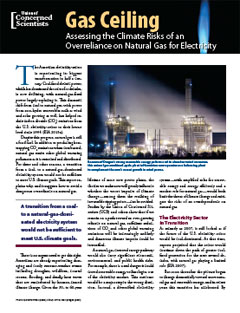Natural gas is a fossil fuel. It produces heat-trapping carbon dioxide when combusted, and generates other global warming emissions when it leaks during extraction and distribution through pipelines.
As a result, shifting the U.S. from a coal- to a natural gas-dominated electricity system would still generate substantial global warming emissions — and fail to effectively address the growing dangers of climate change.
Natural gas does have a role to play in the U.S. power supply, but an overreliance on natural gas over the long-term will not achieve the emissions reductions needed to address global warming. Instead the U.S. must invest in achieving a low-carbon electricity future by generating more electricity from renewable energy sources and improving energy efficiency.
The U.S. is currently moving towards a natural gas-dominated electricity system
- The U.S. electricity sector is experiencing its biggest transformation in half a century as power companies retire many aging, economically uncompetitive coal-fired power plants. In 2008, coal generated 48 percent of the nation's power. In 2012, it provided only 37 percent.
- Natural gas is replacing most of this coal-fired power. From 2008 to 2012, the amount of electricity generated from natural gas increased more than 50 percent.
- If current trends continue, natural gas is projected to account for nearly two-thirds of U.S. electricity by 2050.
A natural gas-dominated electricity system has significant climate risks and does not represent a long-term solution to global warming
- The electric power sector is the largest contributor to U.S. global warming emissions and currently accounts for approximately one-third of the nation's total emissions. To limit some of the worst consequences of climate change, the U.S. needs to cut power sector carbon emissions 90 percent from current levels by 2050, as recommended by the National Research Council (NRC).
- If the U.S. continues on its current path toward a natural gas-dominated electricity system, the electricity sector would generate up to three times the NRC's recommended amount of carbon emissions.
- There are also other heat-trapping gases associated with natural gas beyond its smokestack carbon emissions. The drilling and extraction of natural gas, and its distribution in pipelines, also results in the leakage of methane — a primary component of natural gas that is 25 times stronger than CO2 at trapping heat.
An appropriate role for natural gas in a low-carbon electricity system
- While simply replacing coal with natural gas is not an effective long-term climate strategy, natural gas does offer some advantages in the near to intermediate term, and it could play a modest role in a clean energy future.
- For example, burning natural gas instead of coal results in immediate public health and environmental benefits, given that natural gas emits much lower amounts of soot and smog-forming pollutants, and no appreciable levels of mercury, arsenic, and other toxic substances.
- Because natural gas generators can be ramped up and down quickly, they can help support the integration of variable renewable resources, contribute to a reliable electricity supply, and be utilized quickly during periods of extremely high electricity demand.
To effectively address global warming, the U.S. must invest in expanding renewable energy and improving energy efficiency
- Renewable energy sources, such as wind and solar power, generate little to no global warming emissions and, together with improved energy efficiency, play an essential role in developing a low-carbon electricity system.
- To meet the NRC's carbon budget for the power sector, the U.S. needs to invest heavily in energy efficiency and increase renewable energy's share of the total power supply to 25 percent by 2025 and 80 percent by 2050.
- In order to meet these goals, the U.S. needs to establish smart policies that move the nation toward a low-carbon electricity future, including enacting strong federal standards for power plants, adopting strong state and federal clean energy policies, strengthening regulations for natural gas hydraulic fracturing, and creating a level playing field for all low-carbon technologies.
- Rights and permissions: You are free to use the charts above without alterations online, in written materials, and in presentations. Any online use must include proper citation and a link to this web page.




